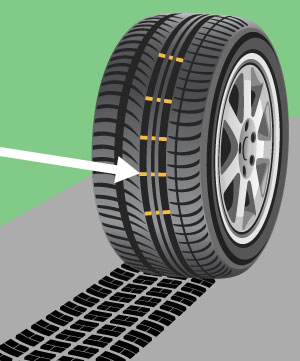Staying Fit
The condition of your tires plays a major role in the maintenance of your entire vehicle. Well-maintained tires provide protection against avoidable breakdowns and crashes, improved vehicle handling, better fuel economy and increased tire life.
See also: NHTSA Tire Resource


AARP Membership— $12 for your first year when you sign up for Automatic Renewal
Get instant access to members-only products and hundreds of discounts, a free second membership, and a subscription to AARP the Magazine.
When caring for your tires, it is important to do the following.
Tire safety checklist
- Check the pressure of all five tires — including the spare — regularly to make sure they are at the pressure recommended by the owner’s manual.
- Always check tire pressure before going on a long trip.
- Inspect tires for uneven wear patterns on the tread, cracks, foreign objects, or other signs of wear or trauma. Remove bits of glass and other foreign objects wedged in the tread.
- Make sure your tire valves have caps and the lug nuts on the wheels are tight.
- Do not overload your vehicle. Check the tire information decal on the driver side door jamb or owner’s manual for the maximum recommended load for the vehicle.
- When purchasing tires, ask the date of manufacture. Recommended shelf life is no more than six years.


Check the tire tread
- Many newer tires have built-in tread-wear indicators that let you know when it is time to replace your tires. When they appear even with the outside of the tread in two or three places, it is time to replace your tires.
- However, because the indicators are only located at certain parts of the tire, they may not show signs of uneven wear that may occur as a result of underinflation, for example. You can also check your tread the old-fashioned way with a quarter. As measured with a gauge, tires are not safe when the tread is worn to 2/32 (1/16 of an inch) or below and should be replaced.


The quarter test
Insert a quarter into the tire’s tread, with Washington’s head toward the tire. If no portion of his head is covered, the tread is below 1/8 of an inch and you should consider replacing your tires soon.
If your car is equipped, look for the tire pressure symbol on your dashboard when you turn on your ignition. If this symbol appears and stays on, then it indicates that your tire pressure is too low. Some vehicles will indicate which tire is underinflated (or you will need to check all tires, including the spare tire, which also has a sensor in some vehicles). Inflate the tire(s) to the appropriate level as indicated in your owner’s manual. Once the tires have been properly inflated, the symbol will disappear the next time you drive your vehicle.
If your car is equipped, look for the tire pressure symbol on your dashboard when you turn on your ignition. If this symbol appears and stays on, then it indicates that your tire pressure is too low. Some vehicles will indicate which tire is underinflated (or you will need to check all tires, including the spare tire, which also has a sensor in some vehicles). Inflate the tire(s) to the appropriate level as indicated in your owner’s manual. Once the tires have been properly inflated, the symbol will disappear the next time you drive your vehicle.
Tire troubleshooting
Look for tire wear and poor inflation by using the table below.
| Clue | Cause | Remedy |
| Both edges worn | Underinflation | Add more air; check for leaks |
| Center treads worn | Overinflation | Let air out to manufacturer’s specifications |
| One-side wear | Poor alignment | Have wheels aligned |
| Treads worn unevenly, with bald spots | Wheel imbalance and/or poor alignment | Have wheels balanced or aligned |
| Erratically spaced bald spots | Wheel imbalance or worn shocks | Have wheels balanced or replace shocks |
| Edges of front tires only worn | Taking curves too fast | Slow down! |
| Saw-toothed wear pattern | Poor alignment | Have wheels aligned |
| Whining, thumping and other abnormal noises | Poor alignment, worn tires or shocks | Have wheels aligned or buy new tires or shocks |
| Squealing on curves | Poor alignment or underinflation | Check wear on treads and act accordingly |


































































More From AARP
Is Your Vehicle Road Ready?
If your vehicle is in poor condition, you are increasing your risk of breakdowns and crashesAntilock Brakes — Know How They Work
3 steps to effectively using your ABS brakes in an emergency